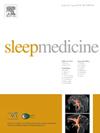阻塞性和中枢性睡眠呼吸暂停相关药物的信号检测。
IF 3.8
2区 医学
Q1 CLINICAL NEUROLOGY
引用次数: 0
摘要
我们的目标是发现药物诱发睡眠呼吸暂停(SA)的新安全信号,这是一个影响全球约 10 亿人的全球性健康问题。我们首先在法国医疗保健数据库随机抽样的Echantillon Généraliste des Bénéficaires (EGB)中,对2006年至2018年间首次接受睡眠呼吸暂停诊断或治疗的所有患者组成的队列进行了一系列序列对称性分析(SSA)。我们使用两个主要结果来估算法国现有所有药物类别的序列比(SR):一个是敏感结果(SA 的诊断或治疗),另一个是特定结果(气道正压(PAP)疗法)。然后,我们使用 "贝叶斯神经网络法 "对世界卫生组织(WHO)药物警戒数据库中截至 2023 年 11 月报告的所有睡眠呼吸暂停病例(MedDRA 高级术语)进行了比例失调分析。在 728,167 人中,46,193 人曾被诊断或治疗过睡眠呼吸暂停,17,080 人曾接受过 PAP 治疗。58类药物具有显著的SR,其中7类药物被认为具有高度可信性:鸦片生物碱及其衍生物、苯二氮卓衍生物、其他中枢作用药物、其他抗焦虑药、氨基甲酸酯、奎宁及其衍生物和抗眩晕制剂;在比例失调分析中发现前3类药物具有一致的信号。在这项信号检测研究中,我们发现阿片类药物、苯二氮卓类药物(但不包括 Z 类药物)和肌松弛剂与 SA 的发生或加重有关。此外,倍他司汀等抗眩晕制剂出现了新的安全信号,需要进一步探讨。本文章由计算机程序翻译,如有差异,请以英文原文为准。
Signal detection of drugs associated with obstructive and central sleep apnoea
We aim to discover new safety signals of drug-induced sleep apnoea (SA), a global health problem affecting approximately 1 billion people worldwide.
We first conducted a series of sequence symmetry analyses (SSA) in a cohort composed from all patients who received a first SA diagnosis or treatment between 2006 and 2018 in the Echantillon Généraliste des Bénéficaires (EGB), a random sample of the French healthcare database. We used two primary outcomes to estimate the sequence ratio (SR) for all drug classes available in France: a sensitive one (diagnosis or treatment of SA) and a specific one (Positive Airway Pressure (PAP) therapy). We then performed disproportionality analyses using the “Bayesian neural network method” on all cases of sleep apnoea (MedDRA high level term) reported up to November 2023 in the World Health Organisation (WHO) pharmacovigilance database.
Among the 728,167 individuals, 46,193 had an incident diagnosis or treatment for SA and 17,080 had started an incident treatment by PAP therapy. Fifty-eight drug classes had a significant SR, with 7 considered highly plausible: opium alkaloids and derivatives, benzodiazepine derivatives, other centrally acting agents, other anxiolytics, carbamic acid esters, quinine and derivatives and antivertigo preparations; with consistent signals found for the first 3 drug classes in the disproportionality analysis.
In this signal detection study, we found that opioids, benzodiazepines (but not Z-drugs) and myorelaxing agents are associated with the onset or aggravation of SA. Moreover, a new safety signal for antivertigo preparations such as betahistine emerged and needs to be further explored.
求助全文
通过发布文献求助,成功后即可免费获取论文全文。
去求助
来源期刊

Sleep medicine
医学-临床神经学
CiteScore
8.40
自引率
6.20%
发文量
1060
审稿时长
49 days
期刊介绍:
Sleep Medicine aims to be a journal no one involved in clinical sleep medicine can do without.
A journal primarily focussing on the human aspects of sleep, integrating the various disciplines that are involved in sleep medicine: neurology, clinical neurophysiology, internal medicine (particularly pulmonology and cardiology), psychology, psychiatry, sleep technology, pediatrics, neurosurgery, otorhinolaryngology, and dentistry.
The journal publishes the following types of articles: Reviews (also intended as a way to bridge the gap between basic sleep research and clinical relevance); Original Research Articles; Full-length articles; Brief communications; Controversies; Case reports; Letters to the Editor; Journal search and commentaries; Book reviews; Meeting announcements; Listing of relevant organisations plus web sites.
 求助内容:
求助内容: 应助结果提醒方式:
应助结果提醒方式:


